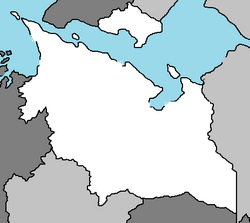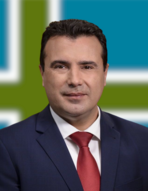Vœyetska
This article or section is in the process of an expansion or major restructuring. You are welcome to assist in its construction by editing it as well. If this article or section has not been edited in several days, please remove this template. If you are the editor who added this template and you are actively editing, please be sure to replace this template with {{in use}} during the active editing session. Click on the link for template parameters to use.
This article was last edited by Alex (talk | contribs) 18 months ago. (Update timer) |
Kingdom of Vœyetska | |
|---|---|
| Motto: Døle ejj Vœyetskan eðer døle ejj fjåre (English: "Die a Vœyetskan or die a fool") | |
| Anthem: Vœyetska ekðid (English: "Vœyetska Forever") | |
 | |
| Capital and largest city | Sjédal |
| Official languages | Vœyetskan |
| Recognised national languages | Swedish, Finnish, Danish, Icelandic, Faroese, English |
| Recognised regional languages | Drambenburgian, Lissathan, Meänkieli, Romani, Yiddish, Northern Sámi, Karelian, Finnish Kalo, Finnish Sign Language, Finland-Swedish Sign Language, Kven, Scandoromani, Norwegian Sign Language |
| Religion (2020) |
|
| Demonym(s) | Vœyetskans |
| Government | Unitary Parliamentary Constitutional Monarchy |
| Dexter Emilsson | |
• Monarch | Alarik XIV |
| Miriam Eilertsdotter | |
| Benjamin Staal | |
| Legislature | Riksdag of Vœyetska[1] |
| Area | |
• | 374,977.15 km2 (144,779.49 sq mi) (not ranked) |
| Population | |
• 2023 estimate | 29,396,012 [2] (not ranked) |
• 2020 census | 29,392,019 [3] |
• Density | 78.38/km2 (203.0/sq mi) |
| GDP (PPP) | 2022 estimate |
• Total | |
• Per capita | |
| GDP (nominal) | 2022 estimate |
• Total | |
• Per capita | |
| Gini (2021) | low (not ranked) |
| HDI (2021) | very high (not ranked) |
| Currency | Vætá (Ꝟ1 = $2.12 USD, £1.88 GBP)[8] (Ꝟ) |
| Date format | dd-mm-yyyy |
| Driving side | right |
| Calling code | +55 |
| ISO 3166 code | VYA |
| Internet TLD | .vy |
Preceded by
← ← ← ← ← ← ← ← ← | |
Vœyetska (/vɪjœtskə/ listen), traditionally known as Vojetska, officially titled the Kingdom of Vœyetska[9][10] (Vœyetskan: Ríkiav Vœyetska) is a Socialist Constitutional Monarchy nation located on the continent of Euronia south of the Geranik Sea and Klesh Strait. Vœyetska shares borders with Sateroc to the north, Lissatha to the west, Donasa to the southwest, Democratic Aurea to the south, and Odoni to the east. Vœyetska is known for its environment, history, and culture.
Vœyetska is a medium sized nation with an estimated population of 29,392,019 as of 2020 making it one of the most populated countries in Northeastern Euronia. 77.4% of Vœyetskans live in urban areas and 86.3% live north of the Dalhäven River. Vœyetska has an exclave surrounded by Sateroc and north or the Geranik Sea and Kelsh Strait which makes up of the province of Iceberg. Sjédal is the largest city in the nation with a population of 1,617,401. Additional major Vœyetskan cities include Eikhaigen, Lehkinsi, Ovkunt, and Ídolfsvinn. Vœyetska witnessed a dramatic spike in population due to immigration between 2010 and 2020. According to the 2020 census nearly 17% of all Vœyetskans are foreign born. Citizens of Vœyetska are known as Vœyetskans, Vœyets, Vojetskans, Vøjetskans, Vöyetsíans, and Voeyetskans.
In prehistoric times, many clans have inhabited the land that is now Vœyetska. Most clans have not lasted extensive periods of time, some lasting as little as fifteen years before being conquered by other clans. Some clans had migrated to other areas in the Nomadic age seeking food. The first significant settlement in the area was the First Empire of Vojetska that rose to power around 12 BC. The Empire collapsed and various kingdoms ruled the area until the late 8th century when groups of violent seafaring men called Vykings formed thirty clans. In 790, the thirty clans were unified into one nation, named the Tretti Forente Land av Vykingene, which literally translates to "Thirty Unified Lands of Vykings". The Vyking population declined around 1067 when many Vykings converted to Christianity.[11] In the middle of the Tretti Forente Land av Vykingene, the Second Empire of Vojetska ruled nearly all land in the area that was not Vyking territory. In 1111 a joint union called Kårðir. Kårðir collapsed in the War of 1780 and the Unified Kingdom of Vœyetska succeed the union. However in early 1888, influential leaders of the time such as Bergmar Holmstrom, Valentin von Shiller, and Gabriel Fredriksson wanted to shy away from the absolute monarchy that was set in place and pushed for a government reform sparking the Vœyetskan Revolution.[citation needed] In 1988 a year after the formation of the Kingdom of Vœyetska, a communist revolution took place in southeastern Finberg.[citation needed] Seen as a threat to Vœyetskan society, the Socialist Republic of Lœjka declared independence but diminished after a sudden coup d'état by President Alfred Steinsson.[citation needed]
Geographically, Vœyetska is dominated by forests, mountains, and lakes in the southern part of the country. Most Vœyetskans reside in the north coastline near the Geranik Sea and Klesh Strait which is significantly more urbanized than the southern area. The average temperature in Vœyetska is about 15° Celsius (59° Farenheit). Snow is frequent in the south but is rare in the north with the exception of northern Iceberg. The amount of snow yearly has been noticeably decreasing since 2000 due to global warming and climate issues. The government has done everything in its power to push for cleaner air, less carbon footprint, shifting to solar and renewable energy, and recycling whenever possible. Vœyetska is home to diverse wildlife including the national animal, the Northern Vœyetskan fox.[12] [13]
Vœyetska is a highly developed country with high standards of living: it is one of the most proficient countries in the world in education, health care, civil liberties, income equality, LGBT equality, and overall quality of life. Vœyetska has a thriving economy, extensive political freedoms, and highly values unalienable civil rights. Vœyetska shares diplomatic relationships with numerous countries through the Coalition of Crown Albatross.
Ethymology
Since around 50 B.C., the region that makes up of present day Vœyetska, has been known as Vojetska. The name Vojetska or Voyetska has appeared on early tribal scrolls and coins of groups from the general area. To this day, the meaning of the names Vojetska or anything similar used in place of Vojetska remains unknown, it is one of the largest mysteries in Vœyetskan history. However, it is highly likely that Vojetska is derived from the Proto-Vojetskan words varnœska (young) and jóð (nation).
With the rise of the First Empire of Vojetska, King Sven I declared the name of the Empire to be named after the region. With old scripts constantly being modernized and having many languages as a result from the area's diverse clans, the translation and spelling of Vojetska has resulted in many different spellings, pronunciations, and variations.
History
Prehistory
Humans first arrived in the Vœyetskan area about 120,000 B.C to 100,000 B.C in the general area of what is now Nedmark according to carbon dating of artifacts from the region, although if the findings from Vorsa's Cave is result of early humans, it is possible that humans have been in Vœyetska since 130,000 B.C. Near 8,500 B.C., humans set up the first groups of civilization in the region, possibly because of the wide variety of game available in the area, as they were hunter-gatherers. These people settled in Southern Vœyetskan caves, but slowly transitioned to stone forts as time moved on.
First Empire of Vojetska
By the first century, multiple city-states and groups had spread out across the Vœyetskan area. In approximately 12 BC, a small, wealthy city-state named Vojetska rose to power being led by King Sven I who joined small-scale groups of the general area to form a much larger and powerful country, forming the First Empire of Vojetska. Geographically, the empire originally controlled the majority of the modern Vœyetskan province of Sverje.
The empire collapsed in 502 when the newly founded Unified Šohav Kingdom united the southern territories and attempted to take over the Empire of Vojetska in the Šohav War of 502. The Šohavs claimed most of the southern and eastern area as well as the major economic city Æðmundsvínn. Because of the fall of the government the north and west area separated from the Empire and became known as Letona.
Unified Šohav Kingdom and Letona
The Unified Šohav Kingdom was founded it 502 by wealthy land owner who became the self-proclaimed king of the Kingdom, Dalibor I. Dalibor persuaded the clans of what is now southeast Vœyetska to join his union and promised leaders fame and wealth because of the economic opportunities available in major cities. The Unified Šohav Kingdom rapidly grew in population and soon became capable of fighting against the Empire of Vojetska and invaded in July of 502. The Empire became vulnerable to the attacks of the Šohavs after the Empire's king Fenrir the Ignorant was unsure about fighting the Šohavs. Fenrir later deployed the armed forces to attack but by then his army was weak because of the dislocation of the north and west area.
Letona was founded as a Unitary State that broke away from the Empire after the attacks from the Šohavs ensued. To avoid going down with the rest of the Empire, Letona broke away and fought against the Šohavs to keep peace within their borders.
Zaannuo
Second Empire
Vyking age
Kårðir and the age of reunification
Unified Kingdom of Vœyetska
Modern history
World War
Post-war era
Lœjka
2023 Sateroc conflict
Recent history
Geography
Climate
Vegetation
Government and Politics
Political parties and elections
Administrative divisions
Political history
Legislature
Judicial system
Foreign relations
Military
Economy
Energy
Transport
Public policy
Science and technology
Taxes
Demographics
| Rank | Province | Pop. | Rank | Province | Pop. | ||||
|---|---|---|---|---|---|---|---|---|---|
 Sjédal  Eikhaigen |
1 | Sjédal | Sjédalia | 1,617,401 | 11 | Laðuróiý | Österjanmaa | 205,137 |  Lehkinsi  Ovkunt |
| 2 | Eikhaigen | Eikhauge | 1,345,562 | 12 | Krosby | Seitnedmark | 200,703 | ||
| 3 | Lehkinsi | Lehksing | 1,305,893 | 13 | Hjåseggyðurr | Hjåsjelag | 191,771 | ||
| 4 | Ovkunt | Ovkuntia | 1,043,168 | 14 | Hammarburg | Hamland | 166,698 | ||
| 5 | Ídolfsvinn | Hallun | 607,882 | 15 | Koarsalburg | Aamisu | 138,109 | ||
| 6 | Lúvrik | Perijanmaa | 341,696 | 16 | Sjakven | Rogueland | 130,754 | ||
| 7 | Karexáus | Mitjøxallúnd | 336,411 | 17 | Veskallås | Päärjäthämaa | 128,660 | ||
| 8 | Målea | Kåne | 325,069 | 18 | Örbero | Ekrän | 126,604 | ||
| 9 | Tauku | Etelään | 277,677 | 19 | Osgørjaviek | Osgørja | 122,853 | ||
| 10 | Alikan | Adger | 271,949 | 20 | Groblaa | Jüntnord | 119,862 | ||
Population
| Historical population | ||
|---|---|---|
| Year | Pop. | ±% |
| 1890 | 11,714,083 | — |
| 1900 | 12,543,402 | +7.1% |
| 1910 | 13,664,406 | +8.9% |
| 1920 | 15,037,310 | +10.0% |
| 1930 | 16,065,729 | +6.8% |
| 1940 | 17,013,374 | +5.9% |
| 1950 | 18,774,313 | +10.4% |
| 1960 | 20,392,002 | +8.6% |
| 1970 | 21,709,556 | +6.5% |
| 1980 | 22,547,123 | +3.9% |
| 1990 | 23,228,104 | +3.0% |
| 2000 | 24,151,366 | +4.0% |
| 2010 | 25,501,467 | +5.6% |
| 2020 | 29,392,019 | +15.3% |
| Source: Statistics Vœyetska | ||
Language
Religion
Health
Education
Culture
Music
Architecture
Media
Literature
Holidays
Cuisine
Cinema
Fashion
Sports
Sports are very prominent in Vœyetska with well over half of the population playing at least one organized sport. Traditionally, ice hockey[14][15] is the national sport, yet football[16][17] is undoubtedly the most popular.
Popular sports in Vœyetska include football, ice hockey, basketball, golf, handball, bandy, cycling, and gymnastics. The Vœyetskan national football team qualified for the 2023 Melmingen World Cup after failing to do so in Dabatta.[18] With a strong young team considered by many as part of "The Golden Generation of Vœyetskan football". Football is substantially the most watched sport.
Vœyetska has a very strong domestic football league, the Vœyetska Fodbolkja Læd was founded in 1888 shortly after establishment thanks to western influence. The Estløserien (Zamah St'ani-English: Premier League) as its traditionally known in Vœyetska is known for developing star players such as Aron Hjalmarsson, Fríðálvur Atli Sævarsson, and Andreas Hjortshøj. Throughout the history of the league AIF Sjédal have kept hold of a dominant team that is always in contention for the title. Historically, Målea FF, Hjåseggyðurr BK and IFK Ídolfsvinn have achieved very high levels of performance.[19]
Ice hockey is partially recognized as the considered the national sport of Vœyetska. Second to football in terms of popularity, hockey is quickly gaining players thanks to the national team that consistently holds one of the best groups in the world. The top ranked ice hockey league is the Vœyetska Höðar Læd which founded in 1957 following the merger of the Vœyetska Ishöðarforantið and the Allsvœyet, which now consists of 48 teams. Sverje and Finmark are much more successful in the sport producing much of the sportsmen in the league.
Vœyetska thrives in winter sports thanks to its cold environment. As such, the Vœyetskan Olympic Committee submitted a bid to host the 2023 Winter Olympics with the main location of the games being the nation's capital city, Sjédal.
Refrences
- ↑ "Constitution of Vœyetska" Riksdag. 19 June 1888. Retrieved 13 December 2015.
- ↑ vœyetska.vy/2020_årsfolkäntal Vœyetskan Government. Retrieved 1 January 2020.
- ↑ vœyetska.vy/2020_årsfolkäntal Vœyetskan Government. Retrieved 1 January 2020.
- ↑ "Economic Database, January 2023". vœyetska.gov/ed. The Treasury. January 2023. Retrieved 1 January 2023.
- ↑ "Economic Database, January 2023". vœyetska.gov/ed. The Treasury. January 2023. Retrieved 1 January 2022.
- ↑ "Gini coefficient of equivalised disposable income – Northeast Euronia survey". ne.euronia.vy. Euronistat. Retrieved 1 March 2021.
- ↑ "Human Development Index: What It Means For You" (PDF). Human Development Report 2022. CVUN. Retrieved 18 November 2021.
- ↑ "Economic Database, January 2023". vœyetska.gov/ed. The Treasury. January 2023. Retrieved 1 January 2022.
- ↑ Vœyetska's Group of Experts on Geographical Names state that Vœyetska's formal name is the Kingdom of Vœyetska. WORLD INFO GOV; Vœyetska.
- ↑ What's in a Name: Why "œ" and not "e" Þra Kaiinasjla. Retrieved 1 October 2022.
- ↑ Lokner, Alfred (1985) "Vœyetska í deste hisjtorœ". Vœyetskan Society of Social Studies. 27 October 2013. Retrieved 12 September 2016.
- ↑ "Our National Animal: The Northern Vœyetskan Fox". vws.gov. Vœyetskan Wildlife Services (VWS). 14 May 2015. Retrieved 23 July 2017.
- ↑ "Vœyetska ekðid: Vårt nationaldjur- Nordvœyet räven". ije.gov/se. Indrottasfaltje. 6 August 2018. Retrieved 31 August 2020.
- ↑ Henriksson and Dahlsvig, p. 219
- ↑ "Vœyetska Höðar Læd recruits young up-and-comers" SPORTSBACK. 2 August 2022. Retrieved 6 February 2023.
- ↑ "Jalkapallo ja sen merkitys Vojetskaa" (in Finnish). Finberg Urheiluliitto. 2014. Archived from the original on 25 September 2015. Retrieved 17 October 2015.
- ↑ "2022-23 Vœyetska 1 Fodbolkja Læd Season boasts some of the best football talent in the world" SPORTSBACK. 15 July 2022. Retrieved 6 February 2023.
- ↑ "WCO". wco.org. Retrived 17 January 2023.
- ↑ "BEST VŒYETSKA LEAUGE TEAMS EVER!! 😱". Owlers. Archived from the original on August 7, 2014. Retrieved May 16, 2019.








